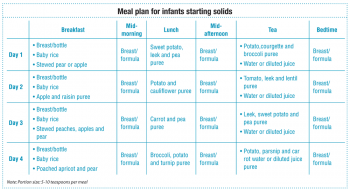CHILD HEALTH
NUTRITION
What to do and how to do it when introducing solids
Weaning babies onto solids is an opportunity for health professionals and parents to make an impact on their current and long-term nutrition
July 1, 2013
-
In the early months of life, infants are totally dependent on mother’s milk or infant formula for their nutritional needs. Solid foods from a spoon are introduced at around six months of age and by one year old, they account for two thirds of the infant’s energy intake. Breast or formula milk accounts for only one-third of energy. Complimentary or solid foods now provide the mainstay of nutrition needs.
The concept of infant programming for adult disease has gained widespread credence in the last 10 years. Research suggests that nutrition in the first 1,000 days, from conception to two years old, has a positive lifelong effect on health. Well-timed nutritional interventions in the first year may be crucial to future health. It is a period of unprecedented growth. At birth an infant’s brain weighs 400g. At 12 months, the weight has increased three-fold proportional to body weight.
The process of moving from a liquid milk diet at birth to sharing in family meals at one year old occurs against a backdrop of well defined stages in attachment behaviour. Good weaning practices will support this attachment sensitive period and program food choices well into childhood.
Setting the scene
The choice of breast feeding or formula feeding has a huge impact on weaning onto solid foods. While breastfeeding is the preferred option for all infants, less than half of mothers in Ireland are breastfeeding on discharge from hospital. Whether a baby is breast or formula fed affects appetite regulation, body composition and the timing and choice of solids.
The publication ‘Best Practice for Infant Feeding in Ireland’ (FSAI, 2012) sets out clear guidance for health professionals on stages and milestones for infant feeding in the first year and beyond.
Timing
Weaning is the process of introducing solid foods to infants. The FSAI guidelines suggest that weaning takes place at about six months; infants should not be introduced to solid food before four months (17 weeks) of age and the start of weaning should not be delayed past six months (26 weeks) of age. (FSAI: 46)
In contrast, over 20% of mothers in Ireland wean their infants onto solid food before 12 weeks of age. There is a window during which infants are ready for solids. The signs will differ between infants and may include:
- Slowing of weight gain
- Waking again at night, after having settled into a pattern
- Infants start to put objects into their mouth and show an interest in food while others are eating
- Sitting with support.
Home prepared or commercial
The greater the variety of tastes an infant is introduced to at around six months, the greater the food choices in later childhood. Breastfed infants receive food tastes through mother’s milk while formula fed infants receive these tastes through solids. Infants accept and learn to like strong-tasting foods within weeks if they are given often. Weaning onto a wide range of home-prepared foods helps infants to develop taste and predicts better acceptance in the future.
The first steps
Whatever the choice of feeding, create a relaxed attitude around food. Starting solids is the first major change in eating for infants. Pick a time when baby is alert and relaxed. Early afternoon is often a good time. Give before or during milk feed.
First foods should be soft, wet, smooth and lump free. Sieve the food through a plastic sieve, or blend it in a liquidiser. A liquidiser is essential for meat – slow-cooked casseroles and stews made with meat, vegetables and water are ideal because the meat softens and is easier to liquidise. Suitable first foods include:
- Cooked and pureed vegetables such as potatoes, carrot, parsnip, turnip, onion, butternut squash, sweet potato
- Cooked and pureed fruit such as apple, pear and ripe banana
- Cereals such as rice, corn flour or oats, and wheat from around six months
- Meat sources such as lamb, beef or chicken at around six months
- White fish such as cod and haddock or oily fish such as mackerel, salmon and canned tuna
- Sauce mixes or packet soups are not suitable for children under 12 months, because of the high salt content. Use vegetable water, breast milk or formula instead.
The first spoon feed
Choose a small, shallow plastic teaspoon. Offer one to two teaspoons of food or more if baby is keen. Mix to a thin smooth consistency with breast milk, formula milk or water. When the infant is taking five to six teaspoons at one time, include a second spoon feed. If a baby refuses a food, try again in a day or two.
When parents understand that the initial spitting back of solids is part of the process of handling the new texture, they are encouraged to continue.
 (click to enlarge)
(click to enlarge)
